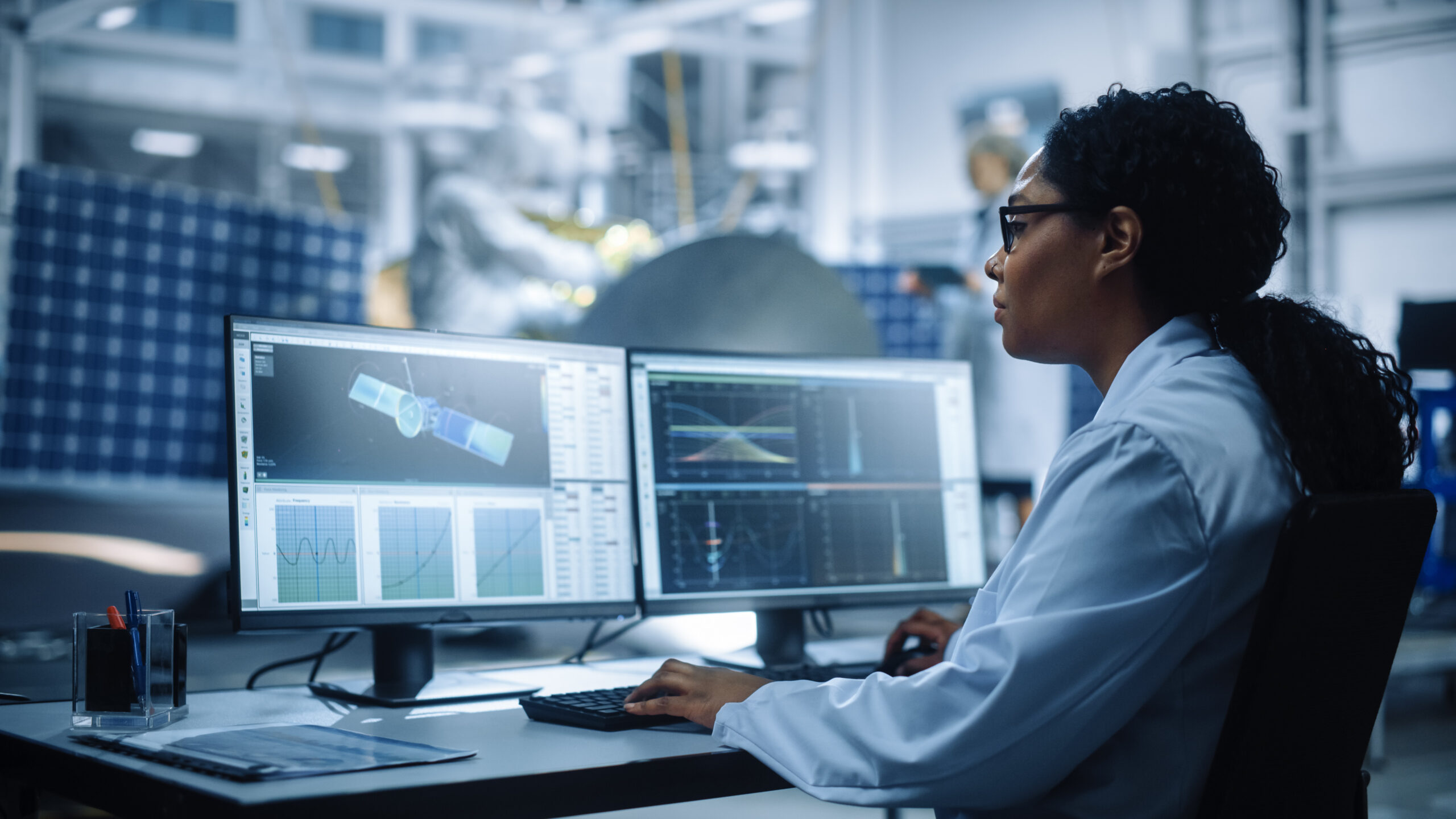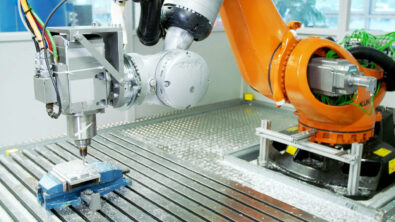Talking Aerospace Today – Automating the Mundane Part One – Transcript

The Talking Aerospace Today ventures into the automation stage of digital transformation maturity. Todd Tuthill begins by explaining how companies can introduce automation by automating mundane engineering processes with some examples.
Listen to the full episode or continue reading below for the full transcript.
Patty Russo: Welcome to Talking Aerospace Today. In our previous episode, our global industry VP for Aerospace and Defense here at Siemens, Todd Tuthill outlined how companies can mature their digital transformation with five steps: configuration, connection automation, generative design, and closed loop optimization. In this and subsequent episodes, we’ll discuss these steps in more depth. Today’s episode will examine automation. So, welcome Todd, and let’s jump right in. Today let’s focus on automation in digital transformation. Before we get into the weeds, though, let’s reiterate the steps for automation, and where the industry currently stands. Refresh us on context.
Todd Tuthill: Sure, Patty. I’d be happy to talk about context and first off, let me say it’s great to be here with you again, and welcome all our listeners back to another incredibly exciting episode of Talking Aerospace today, talking about our favorite topic, digital transformation. Patty, you talked about the five steps. We’ll go over them again. I’ll talk about the first two. You talked about context. So the first two. The first one is configuration that’s simply knowing where your data is being able to store it and find it again when you need it. That’s the first fundamental step in digital transformation maturity.
Todd Tuthill: The second step is connection, and it’s the ability to not just have your data as islands of data, but the ability to understand how one piece of data relates to another and how that fits an ecosystem. And as we talked about a bit on our previous episode, we worked with CIMdata and several industry partners over the last year to do a big report on digital threads. And we saw that in the industry right now, when the aerospace industry thinks about a digital threads and thinks about their data, they look at connection and they’re looking for connection and that’s kind of the big picture goal. They want to connect their data and that’s a very valid goal. Some companies are there some companies are trying to get there. But as we look at that, we say, “Is that really going to get them their full return on investment?” Well, there’s value in connection. There’s real value in the other three steps and that’s where I think we want to talk about today is once you’ve connected your data, how do you put your data to work for you?
Todd Tuthill: And that’s where we kind of want to talk about in our next step beyond traceability, putting our data to work. So that’s I think where we want to go today and kind of sets up, the background.
Patty Russo: Perfect. That’s a great introduction and a great recap. Let’s talk a little bit more. You mentioned that there’s more to connection than just traceability. And I think that leads to the topic of automation as the third step in this digital transformation maturity continuum. Can you give us a little more of a refresher on from your point of view what automation entails and why should we start or focus here on this episode?
Todd Tuthill: Sure. So at its simplest sense, automation is just using another tool, a computer, a machine, something else to do the work that could normally be done by human being. Now, before I scare you and think that we’re talking about Skynet taking over, that’s not what we’re talking about at all. Let me give you a simple example of where automation has really helped me in my life, and probably listeners can identify with it.
Todd Tuthill: We’ll talk about something that happened to me over the weekend, where automation really helped me. So my wife and I are preparing to travel. It’s summer. We’re going to take a vacation soon. And there are some simple products- I live in Tucson. I live in the desert and a lot of people who live in the desert want to get away to a beach vacation over the summer. That’s what we’re going to do. So there’s things that we don’t normally have that we need for beach vacation. So I need to purchase some simple miscellaneous items, okay? And there’s lots of ways I can do it. The way I chose to do it, I pulled out my cell phone. I went to Amazon, to my Amazon app. I searched a couple of keyword searches. I picked a couple of items and I pressed buy. And magically they appeared at my doorstep in 24 hours. Okay? That whole process took me about 45 seconds from time I decided I wanted to buy it until I was done.
Todd Tuthill: Okay? Now let’s think about all the process- Let’s think about how that would work 30 years ago. OK, 30 years ago, you know I live in Tucson. I’m 30 miles South of the city here, and if I wanted to buy these things, what would I have to do? Well, I’d first have to maybe go to the bank and get some money. It was Sunday afternoon. That would have been tough because banks aren’t open on Sunday. So I had to wait till the next day. Go to the bank, get some money, then I might have to drive around three or four or five different stores throughout Tucson to find these little miscellaneous items that I needed, buy them, and come home. The whole process may have taken me four or five hours and I wouldn’t have had access to nearly the variety of products or be able to find what I needed.
Todd Tuthill: So that simple process of an Amazon app with automation saved four or five hours of my life created a better experience for me and allowed me to spend Sunday afternoon with my wife, or Monday afternoon, rather than driving all over the city trying to find these miscellaneous items. That’s an example of how automation through a set of tools and processes has really improved my life and allowed me to do the things I want to do rather than invest it in driving all around on a mundane task. That’s a simple example of how automation makes things better.
Patty Russo: So leave it to an engineer to incorporate the idea of algorithms into a typical day of shopping.
Todd Tuthill: They’re all around us, Patty. The algorithms are there. They help us.
Patty Russo: Exactly. So to that point, the idea of automating the mundane, obviously that’s a very practical application in our everyday life. And, speaking from my own experience, I would much rather spend 45 minutes on an app or 15 minutes on an app then even thinking about going into a store. So let’s talk about automating the mundane in our industry. So you talked a little bit about removing people from the “connection” process going beyond traceability and integrating data systems. Let’s talk about how that applies then to our industry and the engineers. What does this look like? What does this mean?
Todd Tuthill: Sure. So I talked about a mundane task that maybe excites some people. Doesn’t excite me. Shopping, right? I’m not a big shopper, right? So my life is vastly improved by being able to shop in 45 seconds as opposed to four hours. So let’s think about that in the context of engineering. You know, I spent three decades leading engineering teams and I would watch these very talented engineers that worked for me, people who had masters degrees, PhD’s in engineering, understood physics like, you know, you can’t imagine. And I watched what they did. They spend a lot of their days on very mundane tasks looking for data, looking for information, communicating that information to someone else. You know, kind of matching this piece to that piece, finding something that they’d used on a previous program a year ago and trying to put that together.
Todd Tuthill: That’s a simple set of mundane tasks that, frankly, as a director of engineering, I didn’t want to pay engineers to do. Right? I want engineers to do the things they went to school to do, to be innovative, to be creative thinkers, to be critical thinkers. That’s what we’re looking for and that’s what it’s going to take to help them design the products they need to design. And simply the first step in automation, if you think about the foundation that we create from configuration, knowing where my data is at from connecting, knowing how my data is connected, if you have that foundation then I can start doing a lot of those tasks of, you know, think back to my example of I had this product I needed to find. It was actually a strap for my glasses so they would float. Right?
Todd Tuthill: Think about how hard that would be if I was going through a massive department store trying to find that, and all the work and the time it would take, and how much better, how much easier it was that I could just type that phrase into an Amazon app. Okay? And find it and there it was, and it was categorized. There’s a nice picture I could find it and order it. And in one of the simple, mundane things we want in engineering, when we think about in the aerospace context, engineering is a very complex thing. Uses massive amounts of data. We want to reuse things we’ve done before. We need to be able to find and categorize those easily and know that when I find this, I know the quality and readiness of this to be reused. And just the simple task of that, of automating that whole process can save hours and hours and large amounts of time and money in an engineer’s life. That’s just one simple example of automating mundane tasks that we don’t want engineers doing anymore.
Patty Russo: And to that point, I would suspect that engineers would much rather spend their time creating new, exciting things, building, for example, the next sustainable passenger plane or the, you know, innovating the rockets that will bring us back to, or bring us not back to, but bring us to Mars. You you’ve talked before about your data systems are islands connected by rowboats on Excel spreadsheets. Can you give any other examples of mundane work that can be automated from your own experiences in the industry? Obviously you were talking a little bit about your personal experience automating the mundane. Let’s talk a little bit about examples of automating the mundane in in the engineering industry and freeing up engineers to do what they do best, which is engineering.
Todd Tuthill: Sure. So I gave a very simple example of finding things, things engineers do, but there’s far more complex tasks, what I’ll call mundane tasks that can be automated. Back, I used to say five years ago, I guess it’s been longer than that. Now it’s been seven or eight years ago. I won’t name the company and I was working for or with. I’ll just say we were developing a control system for our commercial aircraft, and we were beginning the process of doing all the thousands and 10s of thousands of tests it was going to take to completely verify and certify this flight control system before we could fly it, and I gave my team a challenge. I looked at how we did our work and I said “Okay, there’s a couple of things that I don’t like about the way we do this work.”
Todd Tuthill: It was a sophisticated lab and we took thousands and thousands of test scripts that had to be run to complete these tests. And then once these test scripts have run, we created reams and reams and gigabytes of data that we had to put together to create test reports. I said, “Okay, I don’t want engineers writing test scripts anymore and I don’t want engineers writing test reports anymore.” Two fairly mundane things. I said, “What if we could use models, a model-based system to model the way this works, model our tests and as we describe the tests in the models, we could execute those models? Those models would create the tests, the scripts that would run, and then as the scripts ran, they could create a test report and we wouldn’t have to do that anymore.
Todd Tuthill: And a lot of people thought I was crazy. We’d never done it before, certainly the company I worked for. But I said, “You know, I’m really afraid we’re going to be on the cover of AVWeek if we don’t find some other way to do this work, because we’re just not going to finish this on time.” So that’s the journey we set out on to automate the process of writing test scripts and then as test scripts run to automate the process of creating a test report. That’s exactly what we did. And that to me, is an example from my career where we looked at things from a different way and said “Why do I need to manually write test scripts?” I don’t. We can automate that. We can automate the writing of that test script, and as that test script runs, why can’t it write the test report? And that’s what it did. It saved us an inordinate amount of time and I’m happy to say we helped our customers certify their aircraft on time and they flew it on time.
Todd Tuthill: And certainly there were a number of people and a number of companies that helped that, but that process of automating that mundane thing saved enormous amounts of time. And I’m pretty confident, I doubt that we would have finished that aircraft that went on time had we not followed that process and automated that mundane. And just like the example from Amazon I talked about, it made the lives of engineers easier because they’d have to spend all that time writing and rewriting scripts. But it didn’t just do that, like it saved me, it gave me my whole afternoon back. You know, I it took me 15 seconds to order that strap for my glasses on Amazon as opposed to four or five hours.
Todd Tuthill: A similar thing happened. It saved us enormous amounts of engineering development time because we were not doing all that by hand and maintaining all that by hand. We were starting with models and the models did the rest of the work.
Patty Russo: So this has been a great conversation and the topic is really fascinating. We’d love to talk a little bit more about it today, but we are out of time for this episode. But never fear. We’ll continue the discussion the next time. So thank you, Todd, and thank you to all of our listeners. Be sure to tune in for our next episode of Talking Aerospace Today, where we’ll learn more about the topic of automating the mundane.
Siemens Digital Industries Software helps organizations of all sizes digitally transform using software, hardware and services from the Siemens Xcelerator business platform. Siemens’ software and the comprehensive digital twin enable companies to optimize their design, engineering and manufacturing processes to turn today’s ideas into the sustainable products of the future. From chips to entire systems, from product to process, across all industries. Siemens Digital Industries Software – Accelerating transformation.


